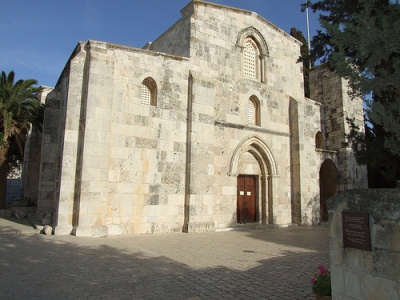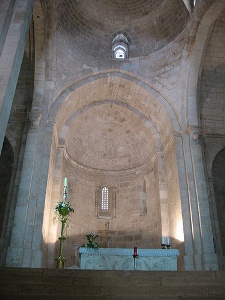

2 Shaar ha- Arayot Street, Jerusalem
Tel. (02) 628 3285
Open: 8am- 12pm & 2- 6pm daily (2- 5pm)

Saint Anne's Church is a medieval church
constructed between 1131 and 1138 replacing an older Byzantine
church. A Christian tradition considers this to be the site where
Saint Anne and Joachim, parents of Virgin Mary, used to live. The
underground remains of their house are situated in the crypt of the
church. Arabic inscription at the entrance states that great Arab
leader Saladin turns the building into a theological school after he
conquered the city from the Crusaders. Eventually it was abandoned
and fell in disrepair. The Ottomans turned possession of the
medieval structure to the France in 1856 that subsequently
reconstructed it.
Part of the Roman temple are found just outside
of the walls of the church. Additionally two cisterns from 8th and
3rd century BC are situated here. In the ancient times they were
used to collect water for the residents of the city and its
surroundings. These were turned into curative baths in the 1st
century BC by Herod the Great.
The church stands on the site of a predecessor
Byzantine church built by Aelia Eudocia in honor of Mary. This church
was destroyed by the Persians in 614, but was rebuilt soon after. Like
other Christian sites in Jerusalem, the Fatimid caliph al-Hakim had this
church destroyed in 1009.
The building you see now was built by
Avda, Baldwin I's widow, in 1142 because it was believed that next to
the Bethesda pond was the home of Joachim and Anna, Maria's parents.
After the conquest of Jerusalem by Sultan Saladin, the church was a
Koranic school from 1192. In 1856, Sultan Abdülmecid gave the building
to Napoleon III as a thank you for supporting the Ottoman Empire in the
Crimean War. At that time, however, the building was in a deplorable
condition. The Turks had believed that the place was bewitched and the
Turkish governor had used the church as a horse stable. The rubbish that
had accumulated inside reached almost to the roof. If you look closely
at the facade of the church, you will notice that the walls are slightly
inclined - an indication of the weights of the vaults not sufficiently
derived from the buttresses. The French government commissioned the
architects Honoré Daumet and Christophe Édouard Mauss (1829–1914) to
carry out the restoration. The building was also freed from
installations from the time of profane use. The church was then
entrusted to the White Fathers by the French government to look after
the site and the pilgrims. From 1878 they also ran the seminary there
for the clergy of the Greek Melchitic Church. Since 1967 Sankt Anna has
been used by the White Fathers as a spiritual center.
The
building has retained its original, austere beauty to this day and is a
testimony to the architecture of the 12th century, probably the most
beautiful surviving Romanesque church in all of Jerusalem. The new high
altar of the three-aisled pillar basilica was made in 1954 by the French
sculptor Philippe Kaeppelin. It depicts the Annunciation, the Nativity
and the Descent from the Cross.
The interior of the church is
known for the long-lasting reverberation. In the right aisle, a passage
leads to an underground grotto, where the birthplace of Mary, the mother
of Jesus of Nazareth, is worshiped.
St. Anne's Church is located in Old Jerusalem near the
Lion Gate and next to the Baths of Bethesda on the north side of the
Temple Mount.
Above the door are five lines in Arabic script from
1192, stating that Saladin, the conqueror of Jerusalem, transformed the
church into a school.
St. Anne's Church consists of a nave and
two aisles, all three of which are the same size. The nave is separated
from the aisles by two colonnades. The base of each column is
cross-shaped. The base of the north and south walls and the base of the
columns are from the 5th century, the rest are from the 12th century.
The eastern end of each aisle and of the central nave is formed by an
apse, the central apse being the largest. The high altar is on an
elevation and stands in the central apse. The high altar was made in
1954 by the French sculptor Philippe Kaeppelin. The Good News, the
Nativity and the Descent from the Cross are depicted on the altar.
In the crypt below the church you can see the cave where Mary is
said to have been born.